
The JPMorgan Chase Tower, formerly Texas Commerce Tower, is a 305.4-meter (1,002-foot), 2,243,013-square-foot (208,382.7 m2), 75-story skyscraper at 600 Travis Street in Downtown Houston, Texas, United States. It is currently the tallest building in Texas and the South Central region of the United States, the tallest five-sided building in the world, the 29th-tallest building in the United States, and the 107th-tallest building in the world.

Downtown is the largest central business district in the city of Houston and the largest in the state of Texas, located near the geographic center of the metropolitan area at the confluence of Interstate 10, Interstate 45, and Interstate 69. The 1.84-square-mile (4.8 km2) district, enclosed by the aforementioned highways, contains the original townsite of Houston at the confluence of Buffalo Bayou and White Oak Bayou, a point known as Allen's Landing. Downtown has been the city's preeminent commercial district since its founding in 1836.
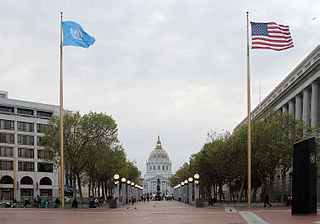
The Civic Center in San Francisco, California, is an area located a few blocks north of the intersection of Market Street and Van Ness Avenue that contains many of the city's largest government and cultural institutions. It has two large plazas and a number of buildings in classical architectural style. The Bill Graham Civic Auditorium, the United Nations Charter was signed in the Veterans Building's Herbst Theatre in 1945, leading to the creation of the United Nations. It is also where the 1951 Treaty of San Francisco was signed. The San Francisco Civic Center was designated a National Historic Landmark in 1987 and listed in the National Register of Historic Places on October 10, 1978.

The Old City Hall is a Romanesque-style civic building and former court house in Toronto, Ontario, Canada. It was the home of the Toronto City Council from 1899 to 1966 and a provincial court house until 2023, and remains one of the city's most prominent structures.

The Etobicoke Civic Centre in the Eatonville neighbourhood of Toronto, Ontario, Canada, once housed the municipal government of the former City of Etobicoke.

Rice Military is a neighborhood in Houston, Texas, United States. The Beer Can House is located in Rice Military.

The architecture of Houston includes a wide variety of award-winning and historic examples located in various areas of the city of Houston, Texas. From early in its history to current times, the city inspired innovative and challenging building design and construction, as it quickly grew into an internationally recognized commercial and industrial hub of Texas and the United States.

Sam Houston Park is an urban park located in downtown Houston, Texas, United States, dedicated to the buildings and culture of Houston's past. The park, which was the first to be established in the city, was developed on land purchased by former Mayor Sam Brashear in 1900.

The Southgate–Lewis House is located one mile east of the Texas State Capitol in Austin, Texas, at 1501 East 12th Street. The house was constructed in 1888, and now stands as an African-American historical landmark. It is also a repository for African-American History and Culture in the region of east Austin, which historically became an African-American neighborhood. The City of Austin has now declared this region to be "Austin's Black Cultural District." The Southgate–Lewis House is located in the center of the "African American Cultural Heritage District".
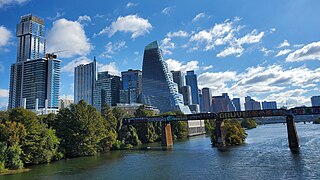
Downtown Austin is the central business district of Austin, Texas, United States. The area of the district is bound by Lamar Boulevard to the west, Martin Luther King Jr. Boulevard to the north, Interstate 35 to the east, and Lady Bird Lake to the south.
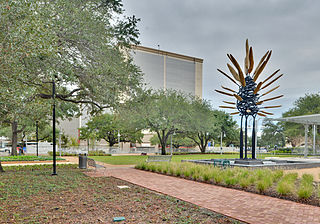
Main Street Market Square Historic District is a historic district in Houston, Texas that includes the Market Square Park. It includes buildings nearby, as well as the square itself. It was listed on the National Register of Historic Places in 1983.
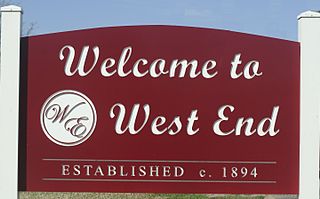
West End is a neighborhood in Houston, Texas, United States located along the Washington Avenue Corridor.

The Cotton Exchange Building is a historic building located in Downtown Houston.

Civic Center is a corridor in the west part of Downtown Houston.

Eugene Thomas Heiner was an American architect who designed numerous courthouses, county jails, and other public buildings in Texas. He was born in New York City, apprenticed in Chicago, and studied further in Germany. His works includes buildings listed on the U.S. National Register of Historic Places.
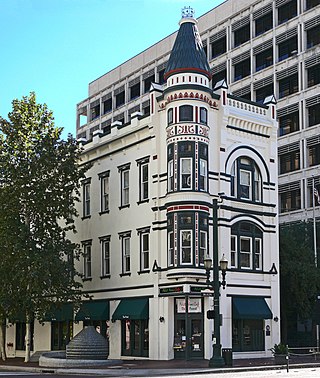
The Sweeney, Coombs, and Fredericks Building is a late Victorian commercial building with a 3-story corner turret and Eastlake decorative elements that was designed by George E. Dickey in 1889. The building is located at 301 Main Street in Houston, Texas and occupies the corner of Main Street and Congress Street in Downtown Houston. The building is one of the few Victorian-style architectural structures that remains in the city. The building received a "City of Houston Landmark" designation in 2009. The building is included in the National Register of Historic Places by virtue of being a conforming structure in the Main Street/Market Square Historic District.

The Paul Building is a high-rise office building located at 1018 Preston Avenue in Houston, Texas. It was listed on the National Register of Historic Places on April 6, 1979. Completed in 1907, the building has been home to a wide range of businesses and professionals. It housed the United States District Court in 1910, and with its proximity to the county courthouse, it became a popular location for attorneys. Its tenants have also included a newspaper, and the Y.M.C.A. The building changed its name to the Hoffman Building in 1918 and then to the Turnbow Building in 1927. It has been known as the Republic Building since 1923.

The Scanlan Building is a building in Downtown Houston.
Thomas Howe Scanlan was a mayor of Houston, Texas. He supported the Union during Reconstruction, and was installed as an alderman and mayor during that period. As well as investing in real estate, he owned stakes in local companies, including rail transportation and utilities.
George E. Dickey (1840–1900) was an architect who worked in the United States and Canada in the 1800s.























